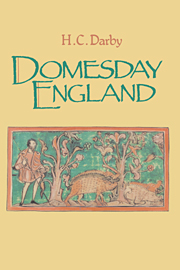Book contents
- Frontmatter
- Contents
- List of Maps
- Preface
- List of Abbreviations
- Chapter I THE DOMESDAY INQUEST
- Chapter II RURAL SETTLEMENTS
- Chapter III POPULATION
- Chapter IV ARABLE LAND
- Chapter V GRASSLAND, MARSH AND LIVESTOCK
- Chapter VI WOODLAND AND FOREST
- Chapter VII ANNUAL VALUES
- Chapter VIII DEVASTATED LAND
- Chapter IX INDUSTRY
- Chapter X BOROUGHS AND TOWNS
- Chapter XI THE WELSH MARCH
- Appendix 1 General Statistical Summary by Domesday Counties
- Appendix 2 Summary of Categories of Rural Population
- Appendix 3 Categories of Rural Population by Domesday Counties
- Appendix 4 Churches and Priests by Domesday Counties
- Appendix 5 The Shropshire Ploughland Formulae
- Appendix 6 The Leicestershire Ploughland Formulae
- Appendix 7 The Yorkshire Ploughland Formulae
- Appendix 8 References to Marsh
- Appendix 9 References to Forests
- Appendix 10 References to Hawks and Renders of Hawks
- Appendix 11 References to firma unius noctis/diei
- Appendix 12 Annual Values for Rural Holdings in 1086 by Domesday Counties
- Appendix 13 References to Iron and Renders of Iron
- Appendix 14 Statistical Summary of Mills by Domesday Counties
- Appendix 15 References to Vineyards
- Appendix 16 Statistical Summary of Boroughs
- Appendix 17 References to Markets
- Appendix 18 References to Mints
- Appendix 19 Extension and Translation of examples of Domesday entries
- Appendix 20 The Domesday Geography of England: Editors and Contributors
- Appendix 21 On the Writing of Domesday Geography
- Index
Chapter V - GRASSLAND, MARSH AND LIVESTOCK
Published online by Cambridge University Press: 05 June 2012
- Frontmatter
- Contents
- List of Maps
- Preface
- List of Abbreviations
- Chapter I THE DOMESDAY INQUEST
- Chapter II RURAL SETTLEMENTS
- Chapter III POPULATION
- Chapter IV ARABLE LAND
- Chapter V GRASSLAND, MARSH AND LIVESTOCK
- Chapter VI WOODLAND AND FOREST
- Chapter VII ANNUAL VALUES
- Chapter VIII DEVASTATED LAND
- Chapter IX INDUSTRY
- Chapter X BOROUGHS AND TOWNS
- Chapter XI THE WELSH MARCH
- Appendix 1 General Statistical Summary by Domesday Counties
- Appendix 2 Summary of Categories of Rural Population
- Appendix 3 Categories of Rural Population by Domesday Counties
- Appendix 4 Churches and Priests by Domesday Counties
- Appendix 5 The Shropshire Ploughland Formulae
- Appendix 6 The Leicestershire Ploughland Formulae
- Appendix 7 The Yorkshire Ploughland Formulae
- Appendix 8 References to Marsh
- Appendix 9 References to Forests
- Appendix 10 References to Hawks and Renders of Hawks
- Appendix 11 References to firma unius noctis/diei
- Appendix 12 Annual Values for Rural Holdings in 1086 by Domesday Counties
- Appendix 13 References to Iron and Renders of Iron
- Appendix 14 Statistical Summary of Mills by Domesday Counties
- Appendix 15 References to Vineyards
- Appendix 16 Statistical Summary of Boroughs
- Appendix 17 References to Markets
- Appendix 18 References to Mints
- Appendix 19 Extension and Translation of examples of Domesday entries
- Appendix 20 The Domesday Geography of England: Editors and Contributors
- Appendix 21 On the Writing of Domesday Geography
- Index
Summary
Meadow and pasture were important elements in village economy in an age when root crops and the so-called artificial grasses were not available. The distinction between them was clear. Meadow was land bordering a stream liable to flood, producing hay, and afterwards used for grazing. Pasture was land available for grazing all the year round. The two varieties of grassland were used to supplement grazing upon the arable fields in their fallow years. Meadow, in particular, was of great value, and thirteenth-century evidence shows that an acre of meadow was frequently two or three times as valuable as an acre of the best arable. Domesday Book records meadow for by far the great majority of villages, except that none appears in the Shropshire folios and none for what is now Lancashire. Pasture, on the other hand, is entered irregularly and not at all for some counties. Marsh is recorded mainly for the Fenland.
MEADOW
Variety of entries
For one circuit, that comprising the five counties of Bedford, Buckingham, Cambridge, Hertford and Middlesex, meadow is for the most part recorded in terms of the teams or the oxen which it could support (Fig. 46). The usual formula is pratum n carucis or pratum n bobus. The amount is usually equal to or less than the number of ploughlands on a holding; this means that it is sometimes in excess of the number of teams actually at work.
- Type
- Chapter
- Information
- Domesday England , pp. 137 - 170Publisher: Cambridge University PressPrint publication year: 1977
- 1
- Cited by



